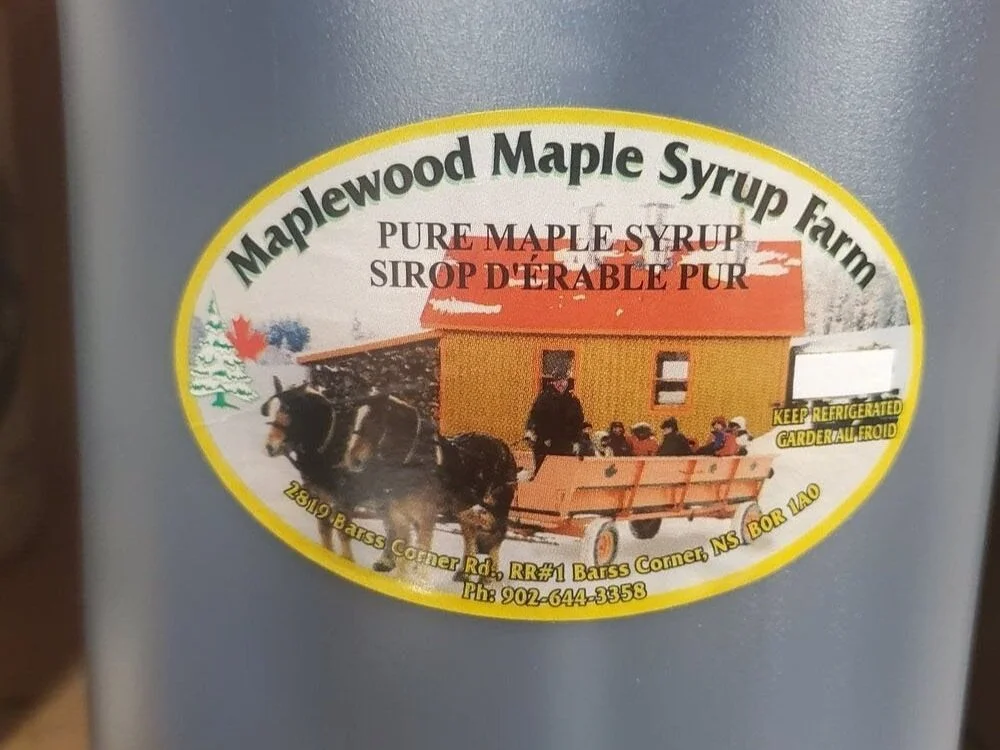A Visit to Maplewood Maple Syrup and Christmas Tree Farm
Introduction
Last week, I was lucky enough to visit Maplewood Maple Syrup and Christmas Tree Farm to speak with the owner, and WWSC member, Rex Veinot. Rex and his family are multi-generational woodlot owners, that have been living and working on the land of this woodlot in Barss Corner, Lunenburg County, for decades. During the visit, we discussed managing the woodlot for multiple values- particularly when it comes to managing a sugar bush and producing maple syrup!
Rex and his family were the recipients of the Nova Scotia Woodlot Owner of the Year Award, not once- but twice, both in 1996 and again in 2009. By speaking with Rex, and by taking a walk through the woodlot, it is clear to see his passion and dedication to sustainable forest management. He views forest management as a way to take care of the forest, and to "leave it in a better condition than how we found it". This management principle guides everything Rex does on this land, and it is clear to see how well taken care of this forest is because of it.
Maplewood Farm Road sign
History of the Land and Previous Forest Management
There are deep roots in this woodlot for the Veinot's, as it has been in the family for multiple generations. Rex himself, was born in the family house on the property, and grew up living and working the land which will eventually to passed down to future generations.
At one time, Rex's grandfather made a living selling maple syrup, eggs, and meat, along with other goods derived from the forest and farm and peddled his wares via horse and carriage to nearby communities. He would leave the property in the morning with a loaded carriage of goods, and ride into different townships such as Mahone Bay, Dalhousie, and New Germany. As time went on, the maple syrup ended up becoming too large of an investment (both in labour and expenses) so his grandfather eventually gave up the maple syrup business.
Rex's father, a carpenter and ship builder, worked the land occasionally, and began working on producing Christmas trees with Rex when he was young. In the 1970's, Rex's father heard of a Woodlot Owner group, that was meant to provide guidance to landowners, through Forest Management Plans. His father asked Rex what he thought of this- and knowing that it could be of benefit to the land, he was all for it. After going to a few meetings, Rex and his father joined the Lunenburg County Forest Management Group in 1972. After this, they became very interested in forest management, and began doing work on the woodlot themselves after having a Forest Management Plan completed. The Forester responsible for writing the management plan told them they had a nice hardwood hill in the back end of their property, and that it would be well suited for a sugar bush if they were interested- this is where the maple syrup journey began!
They started to get involved with the Maple Producers Association of Nova Scotia and began to learn more and more about the process of producing maple syrup, and the management of sugar bushes. After deciding to partake in the maple syrup business around 1974, they set up taps and buckets on about 50 trees and hired a local welder to make them a homemade evaporator which was only about 2ft wide by 4ft long. In the early days, after spending his days working at a building supply store and tending to his herd of cattle, Rex often spent long and cold nights evaporating syrup under a lean-to in the woods until 2 or 3 in the morning, before getting up to do it all over again after only a couple hours of sleep.
Since this time, the business continued to grow each year as they upgraded the system and equipment, allowing for the now 4,300 taps they have today! Although there are less sleepless nights than there was in the early days, there is still plenty of hard work that goes into this operation. It was by no means easy, to accomplish what is here today, but it was certainly a labour of love that brought the farm to this point. In Rex's own words this was "a dream of making sugar, not of making money. If you are able to do what you love, then if you are lucky, someday the money may follow".
Sugar shack on the Woodlot
Tubing system setup in the Maplewood Farm sugar bush
The Maple Operation
Managing a sugar bush for maple syrup production begins with forest management. The stand must be thinned, or selectively harvested, to remove less-desired trees that may be competing with the healthiest sugar maple. This helps to open up the canopy to allow the sugar maple to maintain large, vigorous crowns that will allow them to stay healthy and live for a longer time. Selectively removing these trees also helps to create light conditions suitable for recruiting young sugar maple trees into the canopy and allows them to grow freely, so that one day they can be tapped for their sap. In the early days, Rex began by thinning out much of the beech, while still leaving as much biological and structural diversity in the stand as possible. You can see today that this sugar bush is not just sugar maple- but is filled with a diverse mixture of Acadian Forest species like red oak, yellow birch, red spruce, eastern white pine and beech.
The 4,300 taps are connected by an intricate tubing system which helps to speed up the process of collecting sap from the trees. This system needs to be replaced every 10-15 years once the tubing begins to degrade. As you can imagine, setting up this tubing system is a labour intensive process, and it requires yearly cleaning, constant monitoring, and maintenance to ensure everything is running smoothly and safely.
Tapping maple trees begins late in the winter/early in the spring, when the night temperatures are low, and the daytime temperatures are above 0 ° Celsius, and once tapping begins, it's "all hands on deck" for the Veinot family. Tapping typically lasts anywhere from 45 to 90 days, depending on the temperatures in a given year. It is certainly a busy time of year, but as Rex mentioned- there is rarely a time of year that isn't busy at the Maplewood Farm. Shortly after the maple syrup time is finished, they begin working on Christmas trees.
The sap is transported from the sugar bush to the sugar shack, where it goes through several different stages before becoming syrup. A general rule of thumb is that it takes a minimum of 40 litres of maple sap to produce 1 litre of syrup, but this changes year to year, depending on the sugar content or the "degrees brix" in the maple sap. Degrees brix (°Bx) is the measurement unit used to describe the sugar content in a liquid solution, 1°Bx would relate to 1 gram of sucrose in 100 grams of liquid- so the higher the °Bx, the higher the sugar content in the sap, and the less sap you need to produce a litre of syrup. In a typical year in this region, they would expect to have around 2.2-2.3°Bx which would require 45-50 litres of sap for every 1 litre of maple syrup. This is never exact, and changes from year due to different weather conditions. So far this year, the sugar content has been relatively low at 1.7°Bx, and Rex estimated that it would likely take closer to 55 litres of this sap to produce 1 litre of maple syrup.
Before beginning to boil the sap, it is filtered through a reverse osmosis system, which separates pure water from the tree sap. The water that is filtered through as a result of reverse osmosis is incredibly pure and is often sold as clean, filtered water. After going through the reverse osmosis system, the degrees brix in the sap changes from the current 1.7°Bx to 10 °Bx, and then is continually boiled, in a wood-fired evaporator, to further remove the water from the sap. Once the fire in the evaporator is lit, boiling continues pushing the sap through multiple tanks, getting more and more concentrated as it goes. Eventually, the temperature of the syrup reaches the proper boiling temperature to take syrup off. Although this temperature varies depending on the barometric pressure on a given day, it is typically 7.2-7.5°F above the boiling temperature of water, or about 219°F. Once it has reached this point, it then gets pumped into a filter press, which is used to clean the syrup.
By the time, the syrup is completely boiled, filtered, and ready to be bottled, the sugar concentration should be between 66°Bx to 67.5 °Bx, which is the standard sugar content required for maple syrup producers in Nova Scotia.
The syrup produced is bottled and sold throughout mainland Nova Scotia. You may have seen some Maplewood Farm Maple Syrup at local stores and farmer markets in Western Nova Scotia, and perhaps even in Halifax!
Rex working on the evaporator
Bottle of maple syrup from Maplewood Maple Syrup Farm
Maplewood Farm Sugar bush
Advice for landowners
Throughout the years of managing this woodlot for these multiple values, Rex has learned many lessons along the way. When asked, what advice he would have for landowners wishing to manage their woodlots in this way, this is what he had to say:
"First, you need to manage your forest, and you need to have help doing that. Getting an assessment and Forest Management plan done, along with some guidance from Forest Professionals can help assist you with this and see if it's possible to meet your management goals. If you decide that you want to produce maple syrup, you need to join an association like the Maple Producers Association of Nova Scotia and get involved by attending meetings, seminars, and field days to teach you how to get started. You need advice, you can't learn how to make maple products just by reading a book and joining associations like this will help give you that guidance you need."
His final piece of advice was this: "Be prepared for work, it's not easy and you can't expect to make a fortune. If this is what you want to do, you have to press on and try to make things work."
Woodlot owner Rex Veinot Standing next to a red oak in the Maplewood Farm sugar bush
Links:
Maplewood Farm: themaplewoodfarm.webs.com
Maple Producers Association of Nova Scotia: www.novascotiamaplesyrup.com
Federation of Quebec Maple Syrup Producers: www.puremaplefromcanada.com







